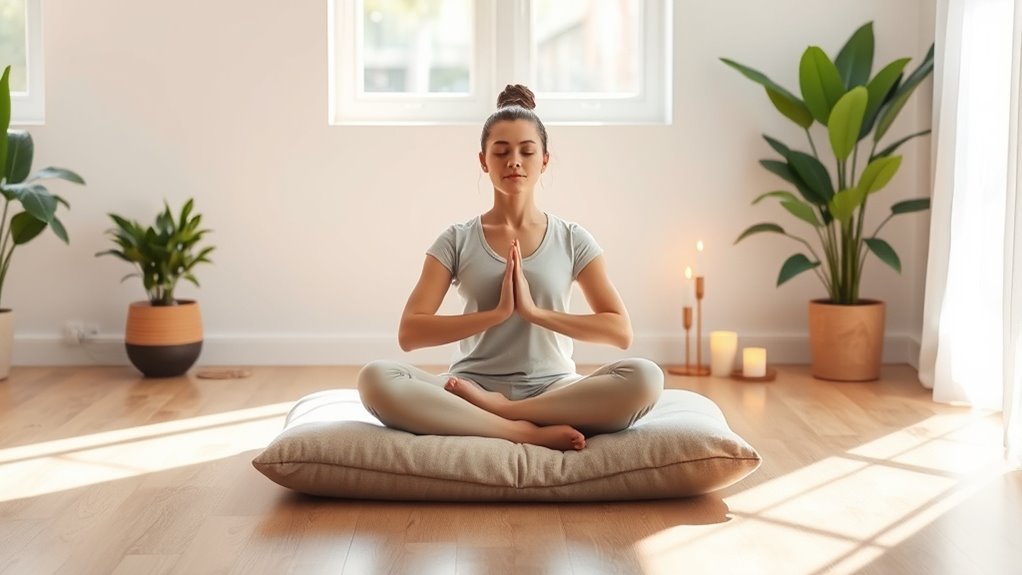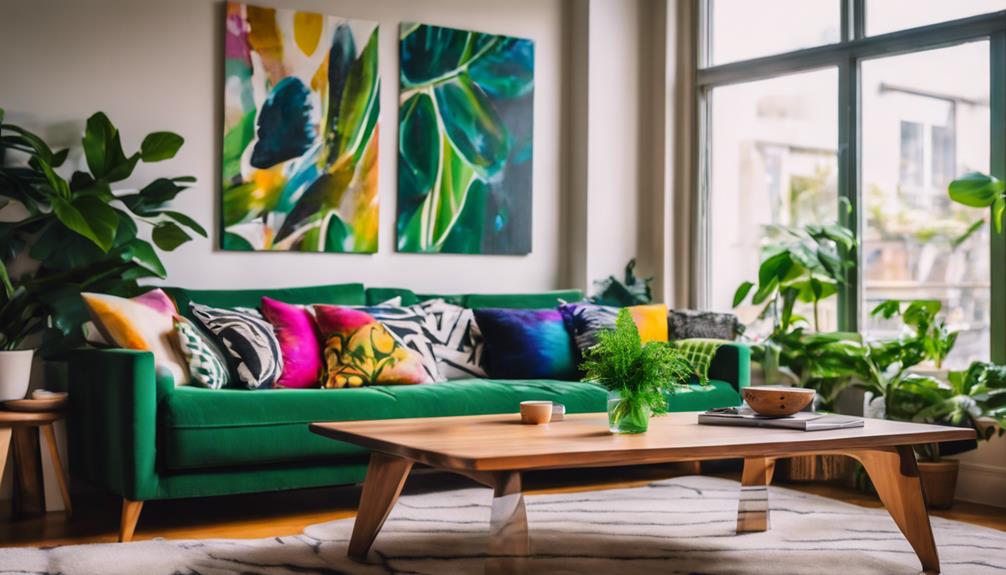Starting meditation and mindfulness as a beginner involves simple practices like focusing on your breath, sensations, or visualizations for about 10 minutes daily. Find a quiet space, sit comfortably, and notice distractions without judgment, gently redirecting your attention. Techniques such as chakra balancing visuals or deep breathing can boost your energy and calmness. Consistency is key, and over time, you’ll notice improved mental clarity, emotional balance, and overall well-being—keep exploring to discover even more ways to enhance your practice.
Key Takeaways
- Start with short, 10-minute guided practices focusing on breath, sensations, or visualization to build a consistent routine.
- Use simple techniques like focusing on your breath or bodily sensations to develop mindfulness skills gradually.
- Find a quiet, comfortable space to meditate and notice distractions without judgment, gently redirecting your focus.
- Incorporate visualization or chakra balancing to enhance energetic alignment and promote calmness.
- Practice daily to develop better attention control, emotional regulation, and overall mental well-being.

Are you curious about how meditation and mindfulness can improve your daily life? Many beginners discover that even brief practices can make a significant difference. One effective way to start is through a short, 10-minute guided visualization. This technique helps you focus your attention, clear mental clutter, and develop a sense of calm. Guided visualization often incorporates imagery that aligns with chakra balancing, where you visualize energy centers in your body becoming open and aligned. As you breathe deeply and focus on these visualizations, you may notice a sense of harmony spreading through your body, enhancing your overall well-being. Color accuracy impacts overall image quality in meditation visuals, improving the clarity of the imagery you focus on. Mindfulness is the human ability to be fully present and aware without overreacting or feeling overwhelmed. Practicing regular mindfulness meditation, even for just a few minutes, boosts your cognitive clarity and attention control. During these sessions, you focus on your breath, sensations, or specific visualizations, gently bringing your attention back whenever your mind wanders. This process strengthens your capacity for attentional regulation and reduces mind wandering. Over time, you’ll find it easier to stay present during daily activities, minimizing distractions and improving focus. This is especially true when you incorporate mindfulness into your routine, such as a body scan meditation or breathing exercises, which can be done comfortably at home or work. One of the key benefits of mindfulness meditation is reducing the activity of the default mode network (DMN), the brain area associated with mind-wandering and ruminative thinking. As you practice regularly, your brain learns to shift focus away from distracting thoughts, supporting better concentration and emotional regulation. This means that outside your meditation sessions, you’re less likely to get caught up in negative or self-referential thoughts, making it easier to handle stressful situations. The calming effects of these practices can even extend into your sleep, helping you feel more rested and emotionally balanced. More and more people are turning to mindfulness meditation, with over 14% of U.S. adults practicing some form of it. Many organizations now include mindfulness in wellness programs, recognizing its role in reducing stress and improving mental health. For beginners, simple techniques like focusing on your breath or doing a body scan can be very effective. Find a quiet spot, sit comfortably, and pay attention to your breath or bodily sensations, noticing distractions without judgment. Gently return your focus when your mind drifts. Even a 10-minute daily session can start to create positive changes, especially if you incorporate chakra balancing visualizations to promote energetic harmony and overall balance. With consistency, you’ll find meditation easier and more rewarding, supporting your journey toward greater mindfulness and well-being.
Frequently Asked Questions
How Long Should I Meditate Daily as a Beginner?
As a beginner, you should aim for 5 to 10 minutes of meditation daily to build strong habits without feeling overwhelmed. Starting with short sessions helps you stay consistent and gradually increase your meditation duration as you grow more comfortable. Even just 2 minutes a day makes a difference. Focus on consistency, and over time, you can extend your practice to 15 or 20 minutes to deepen your experience.
Can Meditation Help With Severe Anxiety or Depression?
Like a gentle tide easing a stormy sea, meditation can help with severe anxiety or depression. Research evidence shows it markedly reduces symptoms, and expert opinions support its use as a valuable treatment option. While not a cure-all, consistent practice can improve emotional regulation and mood. Combining meditation with other therapies enhances benefits, making it a practical tool for managing even intense mental health challenges.
What if My Mind Keeps Wandering During Meditation?
If your mind keeps wandering during meditation, don’t get discouraged. Use distraction management by gently noticing your thoughts without judgment, then refocus with simple focus techniques like your breath or body scans. Recognize wandering as natural, and each time you redirect, you’re strengthening your attention. Over time, this practice helps improve focus, reduces wandering, and builds greater mindfulness. Be patient and consistent—progress comes with practice.
Are There Specific Times of Day Best for Mindfulness Practice?
Think of your mind as a garden that needs tending at the right time. The best timing for mindfulness practice is often in the morning, fitting into your routine like a fresh sunrise. Morning routines set a positive tone, making it easier to stay consistent. While any time can work, starting your day with mindfulness helps you build habits, reduce stress, and stay centered throughout the day.
Do I Need Any Special Equipment to Start Meditating?
You don’t need any special equipment to start meditating. A comfortable seat, like a meditation cushion, can help you maintain good posture and stay focused. If you prefer, guided sessions on apps or online can provide structure and support. You can meditate on a yoga mat or even a chair—whatever feels comfortable. The key is creating a quiet space, so equipment isn’t required for beginning your practice.
Conclusion
So, now that you’re a budding mindfulness master, go ahead and sit comfortably—preferably somewhere that won’t judge you for your wandering thoughts. Remember, meditation isn’t about perfect peace but about noticing your chaos without freaking out. Think of your mind as a wild, caffeinated squirrel—let it run free, then gently coax it back to the present. With practice, you’ll soon be calmly watching that squirrel do tricks instead of chasing its tail.








